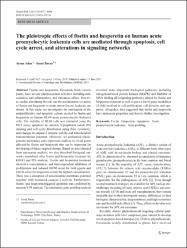| dc.contributor.author | Adan, Aysun | |
| dc.contributor.author | Baran, Yusuf | |
| dc.date.accessioned | 2022-07-19T11:18:00Z | |
| dc.date.available | 2022-07-19T11:18:00Z | |
| dc.date.issued | 2016 | en_US |
| dc.identifier.issn | 1010-4283 | |
| dc.identifier.issn | 1423-0380 | |
| dc.identifier.other | WOS:000366143100087 | |
| dc.identifier.uri | https://doi.org/10.1007/s13277-015-3597-6 | |
| dc.identifier.uri | https://hdl.handle.net/20.500.12573/1317 | |
| dc.description.abstract | Fisetin and hesperetin, flavonoids from various plants, have several pharmaceutical activities including antioxidative, anti-inflammatory, and anticancer effects. However, studies elucidating the role and the mechanism(s) of action of fisetin and hesperetin in acute promyelocytic leukemia are absent. In this study, we investigated the mechanism of the antiproliferative and apoptotic actions exerted by fisetin and hesperetin on human HL60 acute promyelocytic leukemia cells. The viability of HL60 cells was evaluated using the MTT assay, apoptosis by annexin V/propidium iodide (PI) staining and cell cycle distribution using flow cytometry, and changes in caspase-3 enzyme activity and mitochondrial transmembrane potential. Moreover, we performed whole-genome microarray gene expression analysis to reveal genes affected by fisetin and hesperetin that can be important for developing of future targeted therapy. Based on data obtained from microarray analysis, we also described biological networks modulated after fisetin and hesperetin treatment by KEGG and IPA analysis. Fisetin and hesperetin treatment showed a concentration- and time-dependent inhibition of proliferation and induced G2/M arrest for both agents and G0/G1 arrest for hesperetin at only the highest concentrations. There was a disruption of mitochondrial membrane potential together with increased caspase-3 activity. Furthermore, fisetin- and hesperetin-triggered apoptosis was confirmed by annexin V/PI analysis. The microarray gene profiling analysis revealed some important biological pathways including mitogen-activated protein kinases (MAPK) and inhibitor of DNA binding (ID) signaling pathways altered by fisetin and hesperetin treatment as well as gave a list of genes modulated a parts per thousand yen2-fold involved in cell proliferation, cell division, and apoptosis. Altogether, data suggested that fisetin and hesperetin have anticancer properties and deserve further investigation. | en_US |
| dc.language.iso | eng | en_US |
| dc.publisher | SAGE PUBLICATIONS LTD1 OLIVERS YARD, 55 CITY ROAD, LONDON EC1Y 1SP, ENGLAND | en_US |
| dc.relation.isversionof | 10.1007/s13277-015-3597-6 | en_US |
| dc.rights | info:eu-repo/semantics/openAccess | en_US |
| dc.subject | Fisetin | en_US |
| dc.subject | Hesperetin | en_US |
| dc.subject | Apoptosis | en_US |
| dc.subject | Acute promyelocytic leukemia | en_US |
| dc.subject | Gene profiling | en_US |
| dc.title | The pleiotropic effects of fisetin and hesperetin on human acute promyelocytic leukemia cells are mediated through apoptosis, cell cycle arrest, and alterations in signaling networks | en_US |
| dc.type | article | en_US |
| dc.contributor.department | AGÜ, Yaşam ve Doğa Bilimleri Fakültesi, Moleküler Biyoloji ve Genetik Bölümü | en_US |
| dc.contributor.institutionauthor | Baran, Yusuf | |
| dc.identifier.volume | 36 | en_US |
| dc.identifier.issue | 11 | en_US |
| dc.identifier.startpage | 8973 | en_US |
| dc.identifier.endpage | 8984 | en_US |
| dc.relation.journal | TUMOR BIOLOGY | en_US |
| dc.relation.publicationcategory | Makale - Uluslararası Hakemli Dergi - Kurum Öğretim Elemanı | en_US |


















